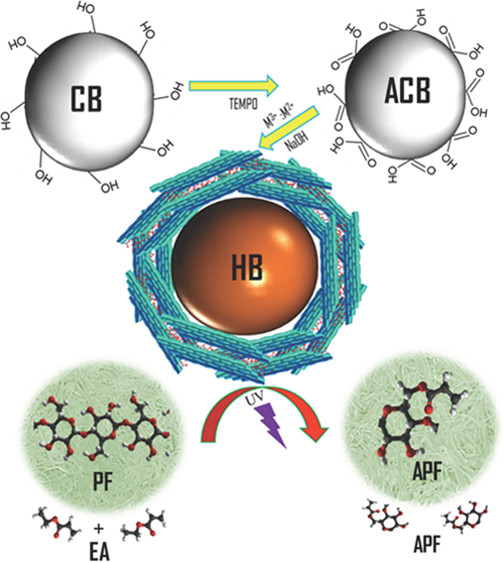Cellulose-based materials are very attractive for emerging bioeconomy as they are renewable, inexpensive, and environmentally friendly. Cellulose beads are spherical and porous and can be highly engineered to be used as catalyst support material. This type of inorganic catalysts is cost-effective and suitable for multiple re-usage and has been rarely explored in cellulose reaction research. In this work, NiFe-layered double hydroxide (LDH) was tailor-made in situ on anionic cellulose beads to form a hybrid, supported photocatalyst for the first time. The hybrid beads were prepared in a size larger than the pulp fibers in order to make the catalysis reaction heterogeneous in nature. Hydrophilic pulp fibers were converted into hydrophobic pulp by photocatalytic topochemical grafting of ethyl acrylate using the LDH-cellulose bead catalyst. The approach identified for the modification of the pulp fibers is the “hydrogen abstraction–UV photografting” because the low-energy, UV radiation-induced grafting offers advantages, such as a reduced degradation of the backbone polymer and a control over the grafting reaction. After grafting, the pulp fibers showed increased water repellency and unaltered thermal stability, indicating the hydrophobic, plasticizing nature of the pulp, which in turn accounts for its thermoformable behavior. These acrylated pulp fibers can be further designed/customized for waterproof or oil absorption applications. bbbb
LijiSobhana S. Sobhanadhas, Lokesh Kesavan, Mika Lastusaari, and Pedro Fardim ACS Omega, 2019, 4 (1), pp 320–330 DOI: 10.1021/acsomega.8b03061 https://pubs.acs.org/doi/full/10.1021/acsomega.8b03061#

Wow, fantastic weblog layout! How long have you ever been blogging for?
you made running a blog glance easy. The entire look of your web site is excellent,
let alone the content material! You can see similar here ecommerce
UID_99106393###
test